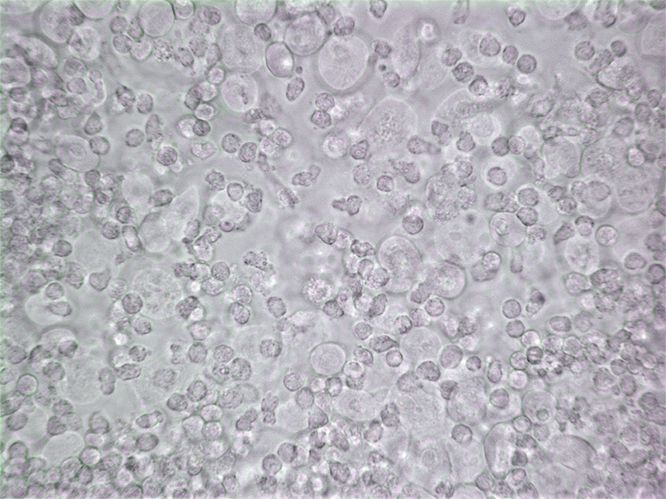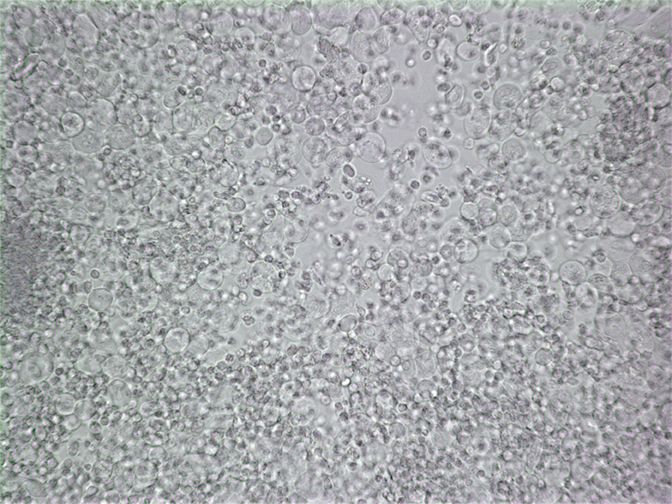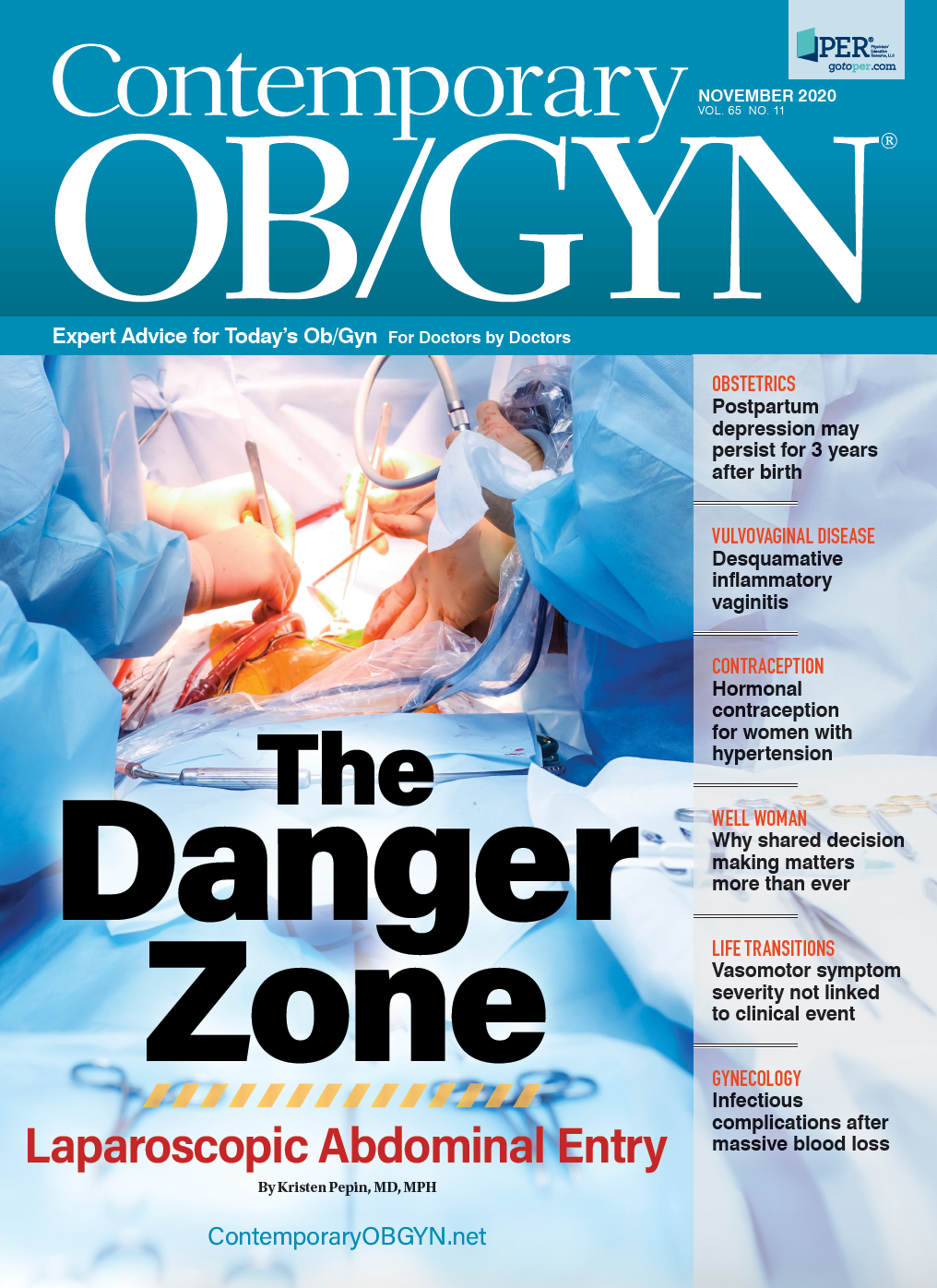Desquamative inflammatory vaginitis
Peer-reviewed
The etiology of this condition is unclear but is consistent with a loss of the normal vaginal flora and increase in inflammation.
Presentation
A 44-year-old woman presents to your clinic in consultation due to issues with vaginal itching and irritation. She has noted yellowish discharge on her pad on a daily basis. No odor noted.
Previously, she underwent treatment with intravaginal clindamycin for 1 week that somewhat helped her symptoms. On examination with a speculum, she is noted to have copious thin yellow discharge on her vaginal mucosa. A wet mount was obtained, with a pH of 6.0.
There is absence of the following: lactobacilli, clue cells, hyphae, trichomonads. Parabasal cells and white blood cells were seen and the whiff test is negative.
Discussion
This patient is presenting with signs and symptoms of vaginitis. There is a broad differential, including candidiasis, bacterial vaginosis, trichomoniasis, gonorrhea or chlamydia infection, lichen planus, atrophic vaginitis, desquamative inflammatory vaginitis (DIV), or a less commonly discussed condition, cytolytic vaginosis. Based on her presentation and her wet mount results, a diagnosis of DIV is made and the patient is treated with intravaginal clindamycin for 3 weeks with resolution of her symptoms.
Gray and Barnes first introduced the DIV condition with their 1965 case series of six women with a “reddened” vagina and “numerous pus cells…with oval and round parabasal cells.”1 The etiology is unclear but this condition is consistent with a loss of the normal vaginal flora and increase in inflammation.
Specifically, it displays a decrease in lactobacilli and an increase in the concentration of obligate or facultative anaerobic flora.2 There is limited literature available about this condition but available studies suggest a prevalence of 2 to 20%.3 It tends to occur more commonly in perimenopausal women but can occur at any age.
Classically, the patient presents complaining of vaginal discharge, itching, vaginal discomfort or dyspareunia.4,5 Externally, the patient may have vulvar erythema (Figure 1).
Figure 1: Vulvar Erythema

On speculum examination, yellow discharge will be apparent, as well as vaginal petechaie.4-6 The patient may have mucosal erythema with bruising or erosions. Approximately 27% ofpatients with DIV will have colpitis macularis or small erythematous macules on their ectocervix.4,5
Diagnosis
The diagnosis is made based on clinical symptoms and physical examination. You should obtain a complete medical history, including sexual history, associated symptoms, and failed treatments. The physical exam consists of placing a vaginal speculum, obtaining a pH from the lateral sidewall of the vagina, and microscopic evaluation of vaginaltions.7
On examination, be sure to evaluate the color, consistency, amount, and odor of vaginal discharge.8
In addition, perform an examination for cutaneous, oral, and vulvovaginal changes to rule out lichen planus.9 Vaginal atrophy needs to be excluded, as atrophic vaginitis and DIV appear similar on microscopic evaluation.
To obtain a sample of the discharge, use a cotton-tipped applicator or sterile 10-microliter plastic loop from the vaginal side wall. A pH of the discharge should also be obtained. The cotton swab is placed directly on the pH paper without adding any saline or potassium hydroxide (KOH), since these will alter the pH. Typically, the pH is greater than or equal to 4.7 in DIV.
Of note, a gram stain alone cannot discriminate between bacterial vaginosis and DIV, and thus, will not be useful.6
Another cotton swab containing vaginal secretions should be placed in a glass tube to which a few drops of saline are added. Spread the sample on two locations on a slide.
On one of the locations, add a drop of KOH. Place coverslips over each sample. Then examine the slide under a microscope at low power (10x) and high power (40x).
On wet mount, there will be an absence of clue cells, hyphae, trichomonads and lactobacilli. Immature vaginal epithelial cells or parabasal cells will be seen. Parabasal cells are typically round or oval in shape with a high nuclear/cytoplasmic ratio.11
High power

You will also see an increase in inflammatory cells (e.g. the ratio of leukocytes to epithelial cells is greater than 1:1).5 No amine odor will be detected on the KOH specimen, in contrast to bacterial vaginosis and trichomonas, which often have this feature.
One might also consider obtaining a yeast culture with speciation as part of the evaluation for vaginal discharge. Nucleic acid amplification tests should also be obtained to rule out other infectious etiologies of vaginitis if indicated.9,10
Low power

Management
As with any vulvovaginal condition, it is important to reinforce appropriate vulvar care measures, including keeping the area dry, avoiding constricting clothing, irritants in detergents, soaps, or over-the-counter medications like benzocaine, and wearing cotton underwear.
Initial treatment for DIV should begin with topical intravaginal clindamycin or intravaginal hydrocortisone. There are a variety of regimens that may be used. For the intravaginal clindamycin, 5g of 2% cream is inserted vaginally once a night for 3 weeks.
Alternatively, 200 mg clindamycin can be inserted intravaginally at night for 3 weeks. For both of these regimens, consider maintenance therapy twice a week, for 2 months, since DIV frequently recurs. Another treatment is intravaginal hydrocortisone. The dosing regimens for intravaginal hydrocortisone are 25 mg suppositories twice a day, for 3 weeks.
Consider maintenance therapy, three times a week for 2 months, following this treatment. At times, a higher dose of hydrocortisone may be required. Hydrocortisone, 300 to 500 mg, is inserted vaginally at night for 3 weeks.
Maintenance therapy, twice a week for 2 months, should be considered with this regimen12; other causes of purulent vaginitis should be excluded.
The main symptoms include purulent discharge, vestibulo-vaginal irritation, and dyspareunia. Examination of vaginal walls will show signs of inflammation with increased erythema and petechiae.
These recommendations are based on an observational study published by Sobel et al in 2011 that looked at the prognosis of 98 patients meeting diagnostic criteria for DIV and a publication by Reichman and Sobel in2014.9,10
In this same 2011 series by Sobel et al, almost a third of patients who had initial resolution of symptoms relapsed within 6 weeks of stopping therapy and approximately 40% relapsed within 26 weeks off therapy.9 Thus, maintenance therapy should be considered as mentioned.12
Regular assessments of signs and symptoms with microscopy and measurement of pH are critical to assess for improvement or remission, as many patients will require maintenance therapy for longer than 2 months.12 In Sobel et al’s 2011 observational study, 58% of the women diagnosed with DIV were still on treatment or had required maintenance therapy 1 year from initial treatment.9
Of note, there do not appear to be systemic effects from prolonged intravaginalsteroid use. However, clindamycin or intravaginal corticosteroids can increase the risk of vulvovaginal candidiasis.9,10 Thus, an antifungal may be warranted, such as oral fluconazole, for patients more likely to get symptomatic candida infections. 9,10
Shared decision-making should occur when choosing a treatment regimen in order to weigh the pros and cons of maintenance therapy, including the risk of vulvovaginal candidiasis and cost.
For challenging cases in which there is no improvement, and in which the patient may have atrophic vaginitis as well, adding intravaginal estrogen may be beneficial.9 The presence of estrogen facilitates colonization of the vaginal microbiome with lactobacilli, which helps to decrease the pH to less than 4.7.10
__
References
1. Gray L, Barnes M. Vaginitis in women, diagnosis and treatment. Am J Obstet Gynecol. 1965;92:125-136.
2. Gardner H. Desquamative inflammatory vaginitis: a newly defined entity. Am J Obstet Gynecol. 1968;102:1102e5.
3. Donders GGG, Bellen G, Grinceviciene S, Ruban K, Vieira-Baptista P. Aerobic vaginitis: no longer a stranger. Res Microbiol. 2017;168(9-10):845-858. doi:10.1016/j.resmic.2017.04.004
4. Sobel JD. Desquamative inflammatory vaginitis: a new subgroup of purulent vaginitis responsive to topical 2% clindamycin therapy. Am J Obstet Gynecol. 1994;171:1215e20.
5. Mitchell L, King M, Brillhart H, Goldstein A. Cervical Ectropion May Be a Cause of Desquamative Inflammatory Vaginitis. Sex Med. 2017;5(3):e212-e214. doi:10.1016/j.esxm.2017.03.001
6. Paavonen J, Brunham RC. Bacterial vaginosis and desquamative inflammatory vaginitis. N Engl J Med. 2018;379(23):2246-2254. doi:10.1056/NEJMra1808418
7. Sherrard J, Wilson J, Donders G, Mendling W, Jensen JS. 2018 European (IUSTI/WHO) International Union against sexually transmitted infections (IUSTI) World Health Organisation (WHO) guideline on the management of vaginal discharge. Int J STD AIDS. 2018;29(13):1258-1272. doi:10.1177/0956462418785451
8. Mason MJ, Winter AJ. How to diagnose and treat aerobic and desquamative inflammatory vaginitis. Sex Transm Infect. 2017;93(1):8-10. doi:10.1136/sextrans-2015-052406
9. Sobel JD, Reichman O, Misra D, Yoo W. Prognosis and treatment of desquamative inflammatory vaginitis. Obstet Gynecol. 2011;117(4):850-855. doi:10.1097/AOG.0b013e3182117c9e
10. Mills BB. Vaginitis: Beyond the Basics. Obstet Gynecol Clin North Am. 2017;44(2):159-177. doi:10.1016/j.ogc.2017.02.010
11. Hasteh F. Parabasal cells. Pathology Outlines. http://www.pathologyoutlines.com/topic/cervixcytologyparabasalcells.html. Published 2020.
12. Reichman O, Sobel J. Desquamative inflammatory vaginitis. Best Pract Res Clin Obstet Gynaecol. 2014;28(7):1042-1050. doi:10.1016/j.bpobgyn.2014.07.003

Current treatments for recurrent bacterial vaginosis leave many patients dissatisfied
February 28th 2025A new study presented at ISSWSH highlights patient dissatisfaction with current treatments for recurrent bacterial vaginosis, emphasizing the need for more effective therapies and improved provider communication.
Read More
Dequalinium chloride found noninferior to metronidazole for BV treatment
May 9th 2024Explore how dequalinium chloride stands as a promising alternative to metronidazole in treating bacterial vaginosis, offering comparable efficacy, safety, and tolerability, as revealed by a recent noninferiority trial.
Read More
